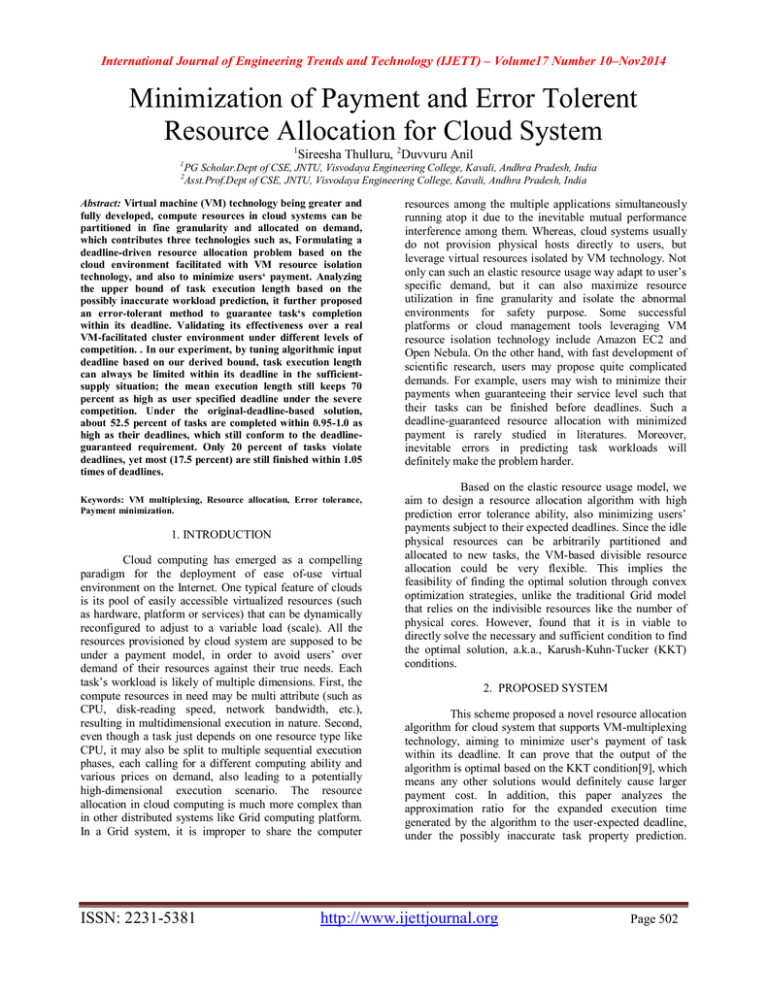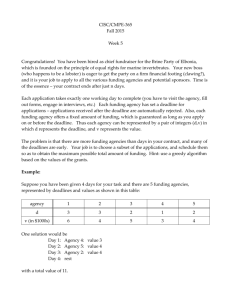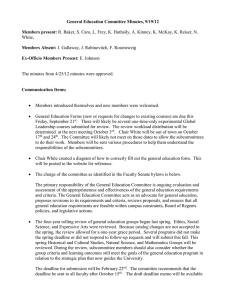Minimization of Payment and Error Tolerent Resource Allocation for Cloud System
advertisement

International Journal of Engineering Trends and Technology (IJETT) – Volume17 Number 10–Nov2014
Minimization of Payment and Error Tolerent
Resource Allocation for Cloud System
1
1
Sireesha Thulluru, 2Duvvuru Anil
PG Scholar.Dept of CSE, JNTU, Visvodaya Engineering College, Kavali, Andhra Pradesh, India
Asst.Prof.Dept of CSE, JNTU, Visvodaya Engineering College, Kavali, Andhra Pradesh, India
2
Abstract: Virtual machine (VM) technology being greater and
fully developed, compute resources in cloud systems can be
partitioned in fine granularity and allocated on demand,
which contributes three technologies such as, Formulating a
deadline-driven resource allocation problem based on the
cloud environment facilitated with VM resource isolation
technology, and also to minimize users‘ payment. Analyzing
the upper bound of task execution length based on the
possibly inaccurate workload prediction, it further proposed
an error-tolerant method to guarantee task‘s completion
within its deadline. Validating its effectiveness over a real
VM-facilitated cluster environment under different levels of
competition. . In our experiment, by tuning algorithmic input
deadline based on our derived bound, task execution length
can always be limited within its deadline in the sufficientsupply situation; the mean execution length still keeps 70
percent as high as user specified deadline under the severe
competition. Under the original-deadline-based solution,
about 52.5 percent of tasks are completed within 0.95-1.0 as
high as their deadlines, which still conform to the deadlineguaranteed requirement. Only 20 percent of tasks violate
deadlines, yet most (17.5 percent) are still finished within 1.05
times of deadlines.
Keywords: VM multiplexing, Resource allocation, Error tolerance,
Payment minimization.
1. INTRODUCTION
Cloud computing has emerged as a compelling
paradigm for the deployment of ease of-use virtual
environment on the Internet. One typical feature of clouds
is its pool of easily accessible virtualized resources (such
as hardware, platform or services) that can be dynamically
reconfigured to adjust to a variable load (scale). All the
resources provisioned by cloud system are supposed to be
under a payment model, in order to avoid users’ over
demand of their resources against their true needs. Each
task’s workload is likely of multiple dimensions. First, the
compute resources in need may be multi attribute (such as
CPU, disk-reading speed, network bandwidth, etc.),
resulting in multidimensional execution in nature. Second,
even though a task just depends on one resource type like
CPU, it may also be split to multiple sequential execution
phases, each calling for a different computing ability and
various prices on demand, also leading to a potentially
high-dimensional execution scenario. The resource
allocation in cloud computing is much more complex than
in other distributed systems like Grid computing platform.
In a Grid system, it is improper to share the computer
ISSN: 2231-5381
resources among the multiple applications simultaneously
running atop it due to the inevitable mutual performance
interference among them. Whereas, cloud systems usually
do not provision physical hosts directly to users, but
leverage virtual resources isolated by VM technology. Not
only can such an elastic resource usage way adapt to user’s
specific demand, but it can also maximize resource
utilization in fine granularity and isolate the abnormal
environments for safety purpose. Some successful
platforms or cloud management tools leveraging VM
resource isolation technology include Amazon EC2 and
Open Nebula. On the other hand, with fast development of
scientific research, users may propose quite complicated
demands. For example, users may wish to minimize their
payments when guaranteeing their service level such that
their tasks can be finished before deadlines. Such a
deadline-guaranteed resource allocation with minimized
payment is rarely studied in literatures. Moreover,
inevitable errors in predicting task workloads will
definitely make the problem harder.
Based on the elastic resource usage model, we
aim to design a resource allocation algorithm with high
prediction error tolerance ability, also minimizing users’
payments subject to their expected deadlines. Since the idle
physical resources can be arbitrarily partitioned and
allocated to new tasks, the VM-based divisible resource
allocation could be very flexible. This implies the
feasibility of finding the optimal solution through convex
optimization strategies, unlike the traditional Grid model
that relies on the indivisible resources like the number of
physical cores. However, found that it is in viable to
directly solve the necessary and sufficient condition to find
the optimal solution, a.k.a., Karush-Kuhn-Tucker (KKT)
conditions.
2. PROPOSED SYSTEM
This scheme proposed a novel resource allocation
algorithm for cloud system that supports VM-multiplexing
technology, aiming to minimize user‘s payment of task
within its deadline. It can prove that the output of the
algorithm is optimal based on the KKT condition[9], which
means any other solutions would definitely cause larger
payment cost. In addition, this paper analyzes the
approximation ratio for the expanded execution time
generated by the algorithm to the user-expected deadline,
under the possibly inaccurate task property prediction.
http://www.ijettjournal.org
Page 502
International Journal of Engineering Trends and Technology (IJETT) – Volume17 Number 10–Nov2014
When the resources provisioned are relatively sufficient, It
can guarantee task‘s execution timealways within its
deadline even under the wrong prediction about task‘s
workload characteristic.
candidate nodes, and estimates the minimal payment of
running the task within its deadline on each of them. The
host that requires the lowest payment will run the task via a
customized VM instance with isolated resources.
It can guarantee task‘s execution time always
within its deadline even under the wrong prediction about
task‘s workload characteristic.
Suppose there are n compute nodes (denoted by pi, where 1
≤ i ≤ n). For any particular task with R execution
dimensions, we use П to denote the whole set of
dimensions and c(pi)=(c1(pi),c2(pi),…,cR(pi))T as node pi’s
capacity vector on these dimensionsNode pi’s availability
vector (denoted a(pi)) along the multiple dimensions is
calculated by c(pj)-∑ti running on pi r(ti) f there are no
workloads being executed simultaneously for a particular
task, its total execution time will be the sum of the
individual processing times on different dimensions. If the
execution of the workloads overlaps, however, the task’s
completion time would be shorter. Accordingly, ti’s final
execution time (denoted as T (ti)) is definitely confined
within such a range [max( ),∑
].
1) It formulate a deadline-driven resource allocation
problem based on the cloud environment facilitated with
VM resource isolation technology, and also proposed a
novel solution with polynomial time, which could
minimize users ‘payment in terms of their expected
deadlines.
2) By analyzing the upper bound of task execution length
based on the possibly inaccurate workload prediction, it
further proposed an error-tolerant method to guarantee
task‘s completion within its deadline.
3) It validates its effectiveness over a real VM-facilitated
cluster environment under different levels of competition.
For simplicity, we denote task ti’s execution time
as (1) (affine transformation of∑
), where denotes a
constant coefficient. Such a definition specifies a defector
broad set of applications each with multiple execution
dimensions. The typical example is a single job with
multiple sequentially interdependent tasks or some
program with distinct execution phases each relying on
independent compute resources (where =1).
T(ti)= ∑
( )
( )
, where
∈
∑
,1
(1)
3. SYSTEM IMPLEMENTATION
3.1. Optimal resource allocations
Based on the convex optimization theory, the
Lagrangian function of the problem could be formulated as
(2), where and 1,2,. . . ,R are corresponding
Lagrangian multipliers. Note that is a constant defined in
(1) and r is the abbreviation of r(ti) as stated above
Fig. 1 Resource allocation in cloud system
2.1. Advantages of proposed system
Optimal for minimizing the payment cost within
user-defined deadline.
Lower than the real workload that is calculated
after its execution.
The idle physical resources can be arbitrarily
partitioned and allocated to new tasks; the VM
based divisible resource allocation could be very
flexible.
2.2. Problem formulation
Suppose the task’s execution times cost on
computation and disk processing are predicted as 4 and 3
hours, respectively. Upon receiving the request, the
scheduler checks the pre collected availability states of all
ISSN: 2231-5381
F1(r) = (∑
∑
k ( rk - ak ).
) ( ∑
) ( ∑
− )+
(2)
Where,
R=Execution Dimension,
Bk=Price Vector,
Rk=Resource Vector,
Lk=Workload Vector,
D=Deadline,
AK=Available Vector
Accordingly, we could get the Karush-Kuhn-Tucker
conditions (i.e., the necessary and sufficient condition of
the optimization) as below:
http://www.ijettjournal.org
Page 503
International Journal of Engineering Trends and Technology (IJETT) – Volume17 Number 10–Nov2014
situation that Algorithm 1 would face to two categories,
where r (*)E refers to the optimal resource allocation with
the constraint (4)
0,k 0,k = 1,2 . . . , R
∑ ≤D
(∑
−D) = 0
rk ≤ ak(ps),k=1,2, . . . ,R;s=1,2, . . . , n
k(rk – ak(ps)) = 0,k = 1,2, . . . , R;s = 1,2, . . . , n
= ((∑
+bk .∑
+ ² + k) = 0
ir i).
²
1, 2. . . R
(3)
k =
r*E (ti) = r*E (ti)
(4)
r*E (ti) ≠ r*E (ti)
(5)
The first situation indicates that in terms of the
skewed estimation of workload ratios, all the resource
shares calculated by the initial CO-STEP in Algorithm 1
are always no greater than the corresponding capacities.
That is, it is equal to the situation with the assumption that
Inequality:
Where,
R=Resource,
Bk=Price Vector,
Rk=Resource Vector,
Lk=Workload Vector,
D=Deadline,
Ak=Available Vector
r*E (ti) ≼ a (ps)
(6)
In contrast, the second one means that the initial
CO-STEP cannot fulfill the above condition, and the
optimal allocation cannot be found unless a few more
adjustment steps.
3.3. Optimal allocation algorithm
Input: D (ti); Output: execution node ps,r*(ti)
1: for (each candidate node ps) do
2:
= ,C = D(ti), r* = (empty set);
3:
repeat
4:
r(*)(ti,ps) = CO-STEP ( ,C ); / * Compute
optimalron * /
5:
= dkdk& r(*)(ti,ps) > ak(ps)};
6:
= \ ; /* takes away */
7:
C = C - ∑ ; /*Update C* /
8:
r*(ti,ps) = r*(t i,ps) {r* = ak(ps)dk&ak(ps)
is dks upper bound};
9:
until ( = );
10:
r* (ti,ps) = r* (ti,ps) r(*) (ti,ps);
11:
end for
12:
select the smallest p(ti) by traversing
thecandidate solution set;
Based on the Algorithm 1, it is obvious that the local
optimal resource allocation for ti to be executed on a
specified node ps is the most crucial part. In fact, the final
outputted resource allocation solution of the whole
algorithm will be globally optimal around the whole
system as long as each local process on a specified node
(line 2-10) can be proved as optimal resource allocation.
Consequently, this will intensively discuss the local
divisible-resource allocation by specifying a particular
execution node, in the following text. Although Algorithm
1 is proved optimal for minimizing the payment cost within
user-defined deadline of task still maynot be guaranteed
due to two factors, either bounded available resources or
inaccurate workload vectorinformation about the task.
3.2 optimality analysis with inaccurate information
Hence, our objective is to determine the upper
bound of deadline extension ratio. We partition the
ISSN: 2231-5381
4. RESULTS AND DISCUSSION
4.1 Results: OAA and DER
In this graph to measure the performance of the
OAA and DER (Deadline Extension Ratio). The number of
input tasks is shown in the X axis and the deadline
extension ratio results are measured in Y axis. The
experimental results are shown by using the original
deadline D (i.e., D‘=D) in the algorithm.
FIG.4.1 Performance with Deadline D’=D
From Fig. 1, the task’s executions times cannot be
always guaranteed to be executed within their deadlines in
the worst case, no matter how many tasks (1-45) are
submitted. Specifically, even though the system availability
is relatively high (e.g., there are only several tasks
submitted), the average value of deadline extension ratio is
nearly to 0.15.
http://www.ijettjournal.org
Page 504
International Journal of Engineering Trends and Technology (IJETT) – Volume17 Number 10–Nov2014
4.2. Performance with Deadline D=a*D
4.4.Performance with Upper Bound
Fig.4.2. Performance with Deadline D=a*D
Fig.4.4. Performance with Upper Bound
Deadline extension ratio when the deadline D’s
set to a stricter deadline (α*D). When the number (denoted
by m) of tasks submitted scales up to 45, all tasks‘
execution times can be kept nearly to about only 2.00 times
as high as their preset deadlines (D) at the worst situation
(i.e., the highest level shown in the figure).
Optimal algorithm is based on the inaccuracy of
the workload predicted, according to the analysis. From
this figure, we can clearly observe that the prediction
method used can make sure that the lower bound of the
workload predicted (i.e., β value will be set close 0 to 20,
where β is defined is always lower than the real workload
that is calculated after its execution.
With further increasing number of the submitted
tasks, tasks‘ execution times cannot be always guaranteed
because of the limited resource capacities (or the higher
level of competitions on resources), but the mean level is
still kept remarkably lower than 2.25, which means that
most of the tasks can still meet the QoS (i.e., large majority
can be finished before deadlines).
4.3. Performance with Lower Bound
5. CONCLUSION AND FUTURE WORK
5.1 conclusions
This paper proposes a novel resource allocation
algorithm for cloud system that supports VM-multiplexing
technology, aiming to minimize user‘s payment of task and
also endeavor to guarantee its execution deadline
meanwhile. This is proven that the output of this algorithm
is optimal based on the KKT condition, which means any
other solutions would definitely cause larger payment cost.
5.2 Future works
In the future, the plan to integrate these algorithms
with stricter/original deadlines into some excellent
management tools, for maximizing the system-wide
performance. To improve the resource utilization and
reduce the user payment the future work to fix the KKT
based on dual parameters like deadline, cost or bandwidth.
References:
[1]. Armbrust.M, Fox. A, Griffith.R, Joseph.A.D, Katz.R.H, Konwinski.A,
Lee.G, Patterson.D.A, Rabkin.A, Stoica.I, and Zaharia.M (2009),
\Above the Clouds: A Berkeley View of Cloud computing, Technical
Report UCB/EECS-2009-28, EECS Dept., Univ. California, Berkeley.
Fig.4.3 Performance with Lower Bound
Optimal algorithm is based on the inaccuracy of
theworkload predicted, according to the analysis. From this
figure can clearly observe that the prediction method we
used can make sure that the lower bound of the workload
predicted (i.e., α value will be set close 0 to 2, where α is
defined is always lower than the real workload that is
calculated after its execution.
ISSN: 2231-5381
[2]. Boyd.S and Vandenberghe.L(2009),
Cambridge Univ. Press.
\Convex
Optimization,
[3]. Chang.F, Ren.J, and Viswanathan.R, (2010).Optimal Resource
Allocation in Clouds, Proc. IEEE Int el Conf. Cloud Computing, pp.
418-425.
http://www.ijettjournal.org
Page 505
International Journal of Engineering Trends and Technology (IJETT) – Volume17 Number 10–Nov2014
[4]. Gupta.D, Cherkasova.L, Gardner.R, and Vahdat.A, (2006),
\Enforcing Performance Isolation across Virtual Machines in Xen,
Proc.
ACM/IFIP/USENIX Int‘l Conf. Middleware (Middleware ‘06), pp. 342362.
[5]. Huang.L, Jia.J, Yu.B, Chun.B.G, Maniatis.P, and Naik.M,( 2010),
―Predicting Execution Time of Computer Programs Using
SparsePolynomial Regression, Proc. 24th Conf. Neural Information
Processing Systems (NIPS ‘10), pp. 1-9.
[6]. Mao.M and Humphrey.M,(2011), ―Auto-Scaling to Minimize Cost
and Meet Application Deadlines in Cloud Workflows, Proc. Int‘l Conf.
High Performance Computing, Networking, Storage & Analysis (SC ‘11),
pp. 49:1-49:12.
[7]. Matthews.J.N, Hu.W, Hapuarachchi.M, Deshane.T, Dimatos.D,
Hamilton.G, McCabe.M, and Owens.J, (2007), ―Quantifying the
Performance Isolation Properties of Virtualization Systems,
Proc.
Workshop Experimental Computer Science (ExpCS ‘07).
[8]. McElvany.M.C and Stotts.P.D, (1991), ―Guaranteed Task Deadlines
for Fault-Tolerant Workloads with Conditional Branches, Real-Time
Systems, vol. 3, no. 3, pp. 275-30.
[9]. Meng.X, Isci.C, Kephart.J, Zhang.L, Bouillet.E, and Pendarakis.D,
(2010), ―Efficient Resource Provisioning in Compute Clouds via VM
Multiplexing, Proc. Seventh Int‘l Conf. Autonomic Computing (ICAC
‘10), pp. 11-20.
[10]. Nathuji.R, Kansal.A, and Ghaffarkhah.A,(2010), ―Q-Clouds :
Managing Performance Interference Effects for Qos-Aware Clouds,
Proc. European Conf. Computer Systems (EuroSys ‘10), pp. 237-250.
ISSN: 2231-5381
http://www.ijettjournal.org
Page 506





